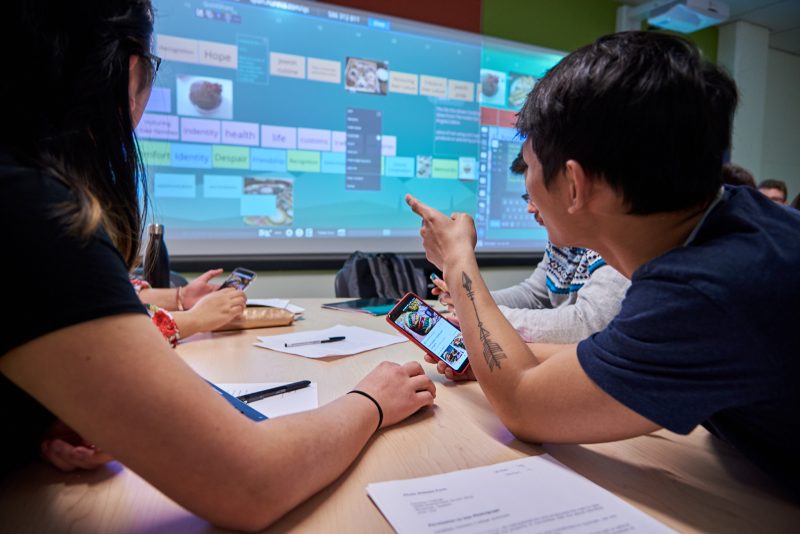(Reprinted with edits from files from Nureva and EducationDive)
Photo credit: Tom Berthelot
Calgary-based Nureva Inc., an award-winning collaboration-solutions company, has partnered with Dawson to create the world’s largest installation of its visual collaboration systems in a single classroom.
The unique configuration is located in an active-learning classroom at Dawson (3H.10) and includes eight Nureva Walls that have created 56 feet or just over 17 metres of digital workspace. This enhances active learning by providing students with more powerful tools for collaboration and expanded interactive space where they can create, visualize and manipulate learning objects while building knowledge together.
It’s been more than a decade since a small group of professors at Dawson started to experiment with active learning. Today, those early initiatives have evolved into a movement that’s transforming the way teachers teach and students learn.
“It has injected new life into the kinds of things I can do in the classroom,” says Chris Whittaker (Physics), one of the College’s early proponents of the student-focused approach to teaching.
Based on the academic literature and research done in his own classrooms, Whittaker is confident that his students learn better when they spend less time listening to him lecture and more time working together through collaborative activities and projects. “Students are getting to much deeper levels of conversation, asking me much more profound questions and engaging with the material in a way that I’ve never seen before.”
To support this growing interest in active learning, the College has created several unique learning spaces equipped with innovative technology tools that are opening up exciting new possibilities for both teaching and learning.
Using technology to shake up teaching
Dawson’s main focus is teaching, so it’s not surprising that an increasing number of its faculty want to make learning more student centered.
Through a combination of research and experience, the college has learned lessons about what works and what doesn’t when it comes to implementing active learning strategies. Importantly, says Whittaker, the development of pedagogical capacity can be enhanced by the right space and the right technology. “When you combine development in the pedagogy, technology and a design of a classroom space, you can get much better learning opportunities,” he explains.
That’s why Dawson College is supporting active learning on several fronts. There’s a thriving learning community for professors who share ideas on using active learning techniques in their teaching. The college has also created three technology-rich active learning classrooms. These unique spaces are filled with interactive tools that enrich the collaboration experience for students and allow professors to “push the envelope” in their teaching practice.
Putting “fantastic learning tools” into the hands of students
When you step inside the active learning classrooms at Dawson, you don’t see a traditional technology setup with one interactive workspace for the teacher. Instead, multiple touch surfaces are spread around the room, giving student groups their own spaces for collaboration.
Two of those high-tech classrooms are equipped with seven interactive whiteboards in each room. And the newest space has eight Nureva™ Walls running Span™ software installed in a single classroom. This unique configuration transforms the walls into 56′ (17.06 m) of digital workspace and is the world’s largest installation of Nureva visual collaboration solutions.
Whittaker says that the goal was to create as many opportunities as possible for students to collaborate, so putting multiple systems in one room simply made sense. “We felt, ‘Why wouldn’t you put a fantastic learning tool into the hands of the people who need it – the learners?’”
That bold and innovative approach is having dramatic effects on the quality of collaboration.
Elizabeth Charles is a researcher at Dawson College who studies the impact educational technology and innovative spaces have on learning. Charles says large shared interactive workspaces give students more room to think and encourage collaborative conversations, which result in deeper learning.
She says because the Nureva Walls can be linked, creating a continuous digital canvas, they add an “exciting” immersive element to the active learning space. “As a teacher, you can create an environment that your students can immerse themselves in.”
Pushing the limits for better learning
Active learning is clearly catching on at Dawson College. Today, nearly 20 percent of faculty members are using these techniques in their teaching. Whittaker expects the new Nureva technology products to spark even more interest. He says professors who were already eager to use the interactive whiteboard classrooms are now “blown away” by what they can now do in the new Nureva room.
“I think we’re starting to understand how far an interactive touch surface can go,” says Whittaker, who is now looking forward to seeing the new directions he and his colleagues can take learning to make it more memorable and meaningful for their students.



